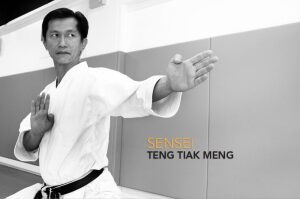Soke Yoshimi Inoue (1946 – 2015) has founded Inoue-ha Shito-Ryu Keishin-Kai (ISK) in 2005 and Sensei Teng (7th Dan Inoue-ha Shito-Ryu) founded Keiseikan with the goal of promoting Inoue-Ha Shito-ryu Karate and engendering a culture of appreciation for this style of martial art. Apart from imparting the vast technical knowledge nested within the various techniques and principles guiding Inoue-Ha, Keiseikan also focuses on its application and practicality, bridging the gap between theory and execution. The focus of Keiseikan karate training is on technique, and not just brute strength alone, which makes it suitable for most people to learn.

Yoshimi Inoue was born in Tottori, Japan in 1946 where he started karate at age 16.
When he became 18 years old, he traveled to Osaka, where he became an “uchi deshi” of Soke Hayashi. In particular, he is the only “uchi deshi” Soke Hayashi ever had.
Additionally, Keiseikan strives to attain a balance between the 3 aspects of karate – kihon (otherwise known as basics), kumite (a kind of combat sport) and kata (also known as pattern or form), with each aspect focusing on a different element that contains each unique learning points. Kihon is the elementary foundation of karate, where one can appreciate the theory and distinct intricacies in the techniques of the Inoue-Ha style.
Kata and Kumite which are arguably the most demanding, builds tenacity, resilience, strategy and physical prowess. Kata on the other hand include the stage of application of the techniques, encompassing other principles, such as discipline and creativity. It is the inclusivity of all 3 aspects in Keiseikan that allows one to fully appreciate the art itself.
Keiseikan also displays its capacity for evolution and adaptability. Without compromising on its roots in Inoue-Ha, it draws certain lessons from multiple martial arts discipline to supplement the Inoue techniques. This is explored in bunkai, otherwise known as the application of a technique, where one can observe the integration of modernity with old martial arts roots when we explore modifications of traditional techniques to better suit certain situations such as street fights or brawls.
Despite its emphasis on techniques, Keiseikan does not neglect the importance of physical fitness and conditioning. Therefore, one can expect the training to include brief but sufficient trainings on conditioning (the act of toughening up the body to deliver and receive hits), break fall and general exercises to strengthen the body. As a whole, if you are interested in building your general fitness and/or understanding the essence of martial arts through ample practice and applications, then Keiseikan is the place for you.